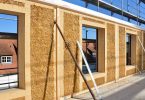Breathability is a misleading term, but it has now become firmly embedded in the vocabulary of building technology. It does at least indicate that the issue is one of importance – if we cease to breathe, we die. It also indicates not only a physical and a dynamic process but also a biological one. In the human body breathing is vital to many physical, chemical and biological processes, and in this context it is the most common and most significant interaction between the self and the world. As such the use of the term breathability to describe the interaction between water and buildings is appropriate. It is one of the most important relationships between the building and the world and it affects almost everything to do with the building health and performance.
Breathability in buildings is not really about air1. It is about water: water as a gas and water as a liquid; water inside the building, water outside the building, and water in the walls, floors and roofs themselves (though not about water in pipes!). It is not only about how water moves through structures (water vapour permeability), but also about the ability of materials to absorb and release water as vapour (hygroscopicity) and about the ability of materials to absorb and release water as liquid (capillarity). Water affects everything in building from the health or decay of building fabric, through to the thermal performance of the building and to the health of occupants. Particularly as we try to increase the airtightness, thermal performance and indoor air quality of our buildings, breathability has become a critical issue, affecting all areas both of new build and of renovation.
Author: Neil May; 16.04.2005







